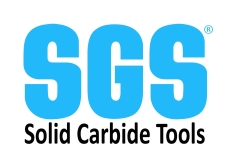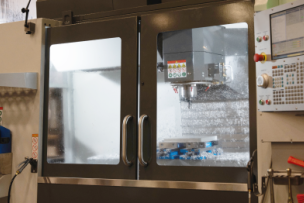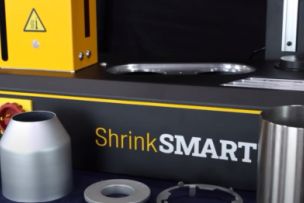ANDY GREAVES: High-efficiency machining is great for those customers that have advanced CAM programs, advanced machines that are rigid, they have a high capability of speed and look ahead on the controller. Not everybody has that. And what SGS kind of prides itself on is working with the big companies, but also the little guys as well. So if somebody is working out of their garage, they've only got a smaller, older machine.
More traditional machining methods have advantages in that arena of a high-efficiency machining.
Narrator: This video is brought to you by SGS. Value at the spindle. If you're looking for real world insights, tips from leading industry experts, the latest trends in products and technology, you've come to the right place. From MSC Industrial Supply, this is Tooling Up.
TONI NEARY: Hello and welcome to Tooling Up. I'm your host, Toni Neary, and I'm so glad that you're here with us today. If it's your first time joining us or you just haven't subscribed yet, go ahead and click that like and subscribe button. You want to make sure you don't miss any upcoming episodes. We have some action-packed manufacturing goodness today, and we're deep diving, literally, into some advanced tooling technology with Andy Greaves, an application engineer at SGS Precision Tools.
Andy, thanks so much for joining us, and welcome to Tooling Up.
ANDY GREAVES: Hey, thanks Toni. It's a pleasure to be here. Really appreciate the opportunity to talk to you today.
TONI NEARY: I am so excited because I love to hear about people's backgrounds, and I love to hear about their journey. It sounds like yours might have started across the pond. Tell us a little bit about your background.
ANDY GREAVES: Sure. Yeah. So when I first started working for SGS, I actually was on, six months placement over here in Virginia. And I was working for an organization called the Advanced Manufacturing Research Center. And I was on a six-month sabbatical working at another research center called the Commonwealth Center for Advanced Manufacturing. So there's kind of a symbiotic relationship between the two, where they have industrial members come together to work on collaborative projects in manufacturing.
Before that, in my childhood, engineering has always been a big thing. My parents both worked in engineering. My uncles and aunts, they all work in engineering as well for the most part. So it's always been a part of my life. And from school I went and studied manufacturing engineering before going to university and studying automotive technology.
TONI NEARY: So tell us a little bit. SGS is so well known for problem-solving innovation, not just for the sake of innovation, but to really make things better. Can you talk a little bit about that SGS philosophy?
ANDY GREAVES: Yeah, so SGS says its main tagline is value at the spindle. And that's really what we target. We're not just selling a customer at all. We're working with them and selling them a solution. So it's not just a case of here's an end mill, good luck, ace. Here's an end mill. This is how we recommend using it. But let's work together to get it dialed in and have the best possible outcome for the product and for the customer.
TONI NEARY: And I tend to be a little nerdy. So there's a lot of talk about HEM or high-efficiency machining for those that are not in the know, which is really cool stuff. But there are situations where those advanced strategies just are not the best fit. Will you talk a little bit about how you really kind of analyze that and figure that out with your customers as well?
ANDY GREAVES: Yeah, that's a great point, Toni. You know, it's kind of a buzzword, HEM, high-efficiency machining. But it's not the answer to everything. There's multiple ways to target an application. So high-efficiency machining is great for those customers that have advanced CAM programs. Advanced machines that are rigid. They have a high capability of speed and look ahead on the controller.
Not everybody has that. And what SGS kind of prides itself on is working with the big companies. But also the little guys as well. So if somebody is working out of their garage, they've only got a smaller, older machine. More traditional machining methods have advantages in that arena over high-efficiency machining. So if a customer just wants to hog our material, make a slot, do some aggressive profiling work, the tools kind of come into their own where we can select the right tool for the right application.
TONI NEARY: And I think that's a really good point. So those jobs needing just brute strength combined with precision and really traditional paths, that's kind of the sweet spot. Let's talk a little bit about what SGS offerings look like in that arena.
ANDY GREAVES: So SGS offers multiple number of tools that can kind of fit into that arena, but our latest and greatest is the new Z-Carb XPR. So it's the newest member of the Z-Carb family, which is what SGS kind of became known for. So we were innovators in variable geometry. And the XPR is the newest tool in that family that really kind of expands on that legacy and focuses on traditional machining techniques where a heavy radial cut is required or there's aggressive ramping or slotting capabilities. So XPR actually stands for extreme plunging and ramping and it has geometries that are key for those applications.
TONI NEARY: Alright, extreme plunging and ramping sounds pretty intense. So there's a tool that's designed to be pushed hard I would imagine. But what is it about this design that makes it so good at handling those aggressive cuts and, you know, getting the chips out of the way?
ANDY GREAVES: Yeah, that’s a great question. The XPR is really tailored specifically to do these sort of applications. And a key part of that is the revised geometry on the end. So as an open tooth design, which allows for efficient chip evacuation and then also there's wiper flaps on two of the flutes on the end.
So we also are able to achieve a really high surface finish when using it as a finishing tool. But the core diameter of the tool is also a bit narrower than some of our other tools. So we're able to efficiently produce a chip with the flute geometry, but then evacuate it out of the way and get it away from the cutting zone to stop it reentering cut, being recut, causing chatter or surface finish damage to the component.
TONI NEARY: All right, so I love turning it up to 11. That's got to do great things for cycle time. But what about tool life and the range of materials that this beast can really handle?
ANDY GREAVES: The range of materials that the XPR can handle. We've not actually found one that it really can't do. We've tested it in a multitude of materials. It works really well. Obviously it's not geared for non-ferrous materials. We do have tools that are specifically designed for that. But in terms of steels, stainless steels, heat resistant super alloys, hardened materials, this tool really is versatile and it is the kind of the key to productivity for our customers.
TONI NEARY: All right Andy, this XPR can do roughing, slotting, achieving a decent finish. I mean shops it sounds like they can consolidate tools, reduce set up and running times. Where are you seeing good applications and like how hard of a material can this really work with?
ANDY GREAVES: So the question about hardness is a really good one Toni, because when people say hard material is not hard, hard to some people is different. But we've run this tool successfully in up to 60 Rockwell steels. So it's great for those mold and die shops. It's great for job shops. And that's where we're finding a lot of success.
You know these guys, they don't want one tool per operation. They want something that's really versatile that they can trust that they know is going to work. So one day they might be cutting some steel, one day they might be cutting some inconel, the next day they might be doing some stainless steel. So the XPR has that versatility and that capability to effectively cut all those materials at different parameters and give the customer what they need.
We have customers that have adapted the XPR from competitor tools, and they've successfully gone from say, five components per tool, and we've more than doubled the tool life, but they've also used it on other jobs as well. So we're not just doubling the tool life on one job, we're doing it across multiple parts, and their tool drawer is gone from 4 or 5 different tools to in some cases just an XPR.
And it's that sort of result and that sort of versatility that the XPR is really like geared towards giving the customer.
TONI NEARY: Andy, this has been absolutely fantastic. I know I've learned something today and I'm thinking every shop out there should be looking at XPR and making this a fit for them. Thank you so much for joining us and sharing your time and your expertise with us.
ANDY GREAVES: Thank you Toni. It's been a real pleasure to be here. And I'm glad that our listeners and viewers have learned something. And again, thank you for your time.
TONI NEARY: It was so great hanging out with Andy today and if you enjoyed our conversation as much as I did, go ahead and make sure to subscribe so you don't miss any upcoming episodes. To find out more about SGS’ XPR end mill, and how you can bring value to your spindle with it, go to www.mscdirect.com/sgs. Thanks and we'll see you next time on Tooling Up.
Narrator: Want more insights and ideas to improve the efficiency and productivity of your operations? Check out the Tooling Up video playlist to hear tips that can take your company to the next level, and subscribe to our channel so you won't miss out.




Talk to Us!
Leave a reply
Your email address will not be published. Required fields are marked *